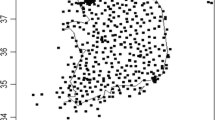Summary
Six methods were used to interpolate the monthly mean climatological data from German climate stations to three Bavarian forest climate stations. The observed forest climatological data at the Bavarian forest climate stations were used as the reference data to which the interpolated data were compared. The results show that, for monthly mean daily maximum temperature at valley and plain forest climate stations, each of the six interpolation methods can give accurate estimates. For monthly mean daily maximum temperature, minimum temperature, air temperature and water vapor pressure at mountain forest climate stations, topographically aided interpolation can give the most accurate estimates. Barnes interpolation combined with empirical transfer functions can give accurate estimates forall climate variables at the plain and valley forest climate stations, and it can also give accurate estimates for monthly mean wind speed and monthly precipitation at the mountain forest climate station. The empirical transfer functions are very important for estimating the forest climatological data. These transfer functions will be used for reconstruction of long-term forest climatological data in Bavaria.
Similar content being viewed by others
Author information
Authors and Affiliations
Additional information
Received September 9, 1998 Revised May 21, 1999
Rights and permissions
About this article
Cite this article
Xia, Y., Winterhalter, M. & Fabian, P. A Model to Interpolate Monthly Mean Climatological Data at Bavarian Forest Climate Stations. Theor Appl Climatol 64, 27–38 (1999). https://doi.org/10.1007/s007040050108
Issue Date:
DOI: https://doi.org/10.1007/s007040050108




